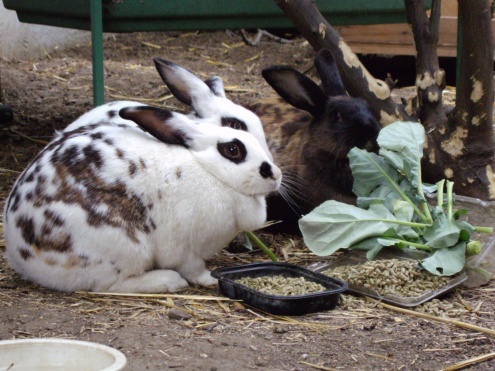All Hallows Eve
Halloween is derived from ‘All-Hallows-Even’, meaning the All Holy Eve, found in the Prayer Book. The Latin term for “Holy”, aka, ‘Sanctus’, comes the word ‘saint’, i.e., “All Saints Eve”. Halloween is a vigil for the dearly departed. The 1928 prayer book offers a prayer during the burial of the dead, “O God, whose mercies cannot be numbered; Accept our prayers on behalf of the soul of thy servant departed, and grant him an entrance into the land of light and joy, in the fellowship of thy saints; through Jesus Christ our Lord” (p. 334).
Scary Purgatory
In the West, ‘All Saints’, aka. Hallows-Mass, or Hallowmas, began in the eighth century as a festival to commemorate ‘Saints, Martyrs, Confessors, and the Just made perfect’. All Saints grew in popularity and status, and by 835 AD the Frankish King, Louis the Pious, made its occasion obligatory for Christians.. By the 15th century, Pope Sixtus IV, affirmed its solemnity with an octave, ranking Hallows Day up with Easter, Whitsun, and Christmas. But in the eleventh century, Odilo of Cluny, added a second day– All Souls. Instead, All Souls recollected ordinary Christians caught in purgatory. Purgatory’s reputation as a residence of devils, torturing men until their satisfaction for sins were paid, made Hallows Eve a scary if not somber occasion. The story of St. Odilo details a harrowing visit from purgatory, not unlike our many ghostly and goulish tales more common to Halloween: Read the rest of this entry »
St. Francis Day
Note: Since mid-February, 2010, I left CCP/ACC for an Anglican Church better centered on Settlement and Reformation principles. I miss CCP’s beautiful worship and people. Visit my Anglican blog here for more of my sundry convictions. Anyway, I wish the CCP the best. Here follows the story of St. Francis and my bunnies!
This belongs to Oct. 4rth, St. Francis Day. Amanda, my girlfriend, and I brought my bunnies for blessings. About a year ago I was hesitant regarding blessings upon animals. But, blessings are prayers conducted by the priests for the well-being of our pets. Our litany contains prayers for both livestock and harvests. I imagine blessings upon animals is old, harkening back to our agricultural days where the survival andprosperity of livestock was important. St. Francis has this curious association about him, making his liturgical day akin to our Prayer Book rogation days. The connection between God, seasons, growth, harvests, and cycles of fast/feast is something I hope to explore. Perhaps re-establishing St. Francis as regularly observed liturgical day would behoove or at least preserve an agrarian memory? Anyway, the prayer I gave for my bunnies were they be protected from the devouring racoons and escape the many hawks in the sky. Life can be very scary for a bunny. Read the rest of this entry »
Raddish Treats
 After I got my drip irrigation system installed (during the summer), my rows of soil replenished and built up, and seed broadcast, I then let the sun do its work! I had ten rows of garden vegetables– beets, kale, spinach, and lettuce. I also planted some tomatoes and corn only because I had some tomato volunteers (which I relocated along the drip line) and extra corn seed left over. I knew both would perish by December or January. Neither do well in cold, but you never know with the mild winter in CA, and, at the very least, green corn stalks are pretty.
After I got my drip irrigation system installed (during the summer), my rows of soil replenished and built up, and seed broadcast, I then let the sun do its work! I had ten rows of garden vegetables– beets, kale, spinach, and lettuce. I also planted some tomatoes and corn only because I had some tomato volunteers (which I relocated along the drip line) and extra corn seed left over. I knew both would perish by December or January. Neither do well in cold, but you never know with the mild winter in CA, and, at the very least, green corn stalks are pretty.
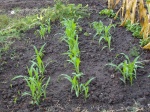 Also, a lot of things I do I learn the hard way. Rather than research things, I tend to experiment. I noticed this summer my corn cobs did not fertilize well. A lot of the kernals were missing on the cob, and this is due to poor fertilization and lack of neighboring corn. This time I packed the corn stalks in so each stalk had lots of neighbors! I am curious to see if I get more kernals this way per cob.
Also, a lot of things I do I learn the hard way. Rather than research things, I tend to experiment. I noticed this summer my corn cobs did not fertilize well. A lot of the kernals were missing on the cob, and this is due to poor fertilization and lack of neighboring corn. This time I packed the corn stalks in so each stalk had lots of neighbors! I am curious to see if I get more kernals this way per cob.
 Since corn grows tall with good sun light reaching underneath, amongst my rows of corn I planted herbs, onions, and raddish. The ‘tiered’ approach worked well, and I imagine it is a excellent one when dealing with plants that do poor in direct, hot sunlight. These would include pumpkins (for fall) and any vine/squash plant in general. I highly recommend using corn to help provide shade for such plants in otherwise hot, sunny areas.
Since corn grows tall with good sun light reaching underneath, amongst my rows of corn I planted herbs, onions, and raddish. The ‘tiered’ approach worked well, and I imagine it is a excellent one when dealing with plants that do poor in direct, hot sunlight. These would include pumpkins (for fall) and any vine/squash plant in general. I highly recommend using corn to help provide shade for such plants in otherwise hot, sunny areas.
 To the right above (and left side) is a picture of my raddishes. Many only grew leaves without bulbs below. Both kinds I gave the leafy stalks to my bunnies. Bunnies love raddish leaves. I also gave my bunnies the roots or stalk end of kale which tend to be very hard and not good for cooking. The leaves (which tend to be large) are really the most edible/cookable part of kale, and they are best picked early on. If you wait they begin to turn ‘blue’ and fiberous. However, kale is exceedingly rich in vitamins. The raddish also get more ‘hot’ or peppery as they are left in the ground. Like beets, raddish roots turn into bulbs and as they rippen they ‘lift’ themselves out of the ground. When they are 2/3 above ground they are more than ready to pick.
To the right above (and left side) is a picture of my raddishes. Many only grew leaves without bulbs below. Both kinds I gave the leafy stalks to my bunnies. Bunnies love raddish leaves. I also gave my bunnies the roots or stalk end of kale which tend to be very hard and not good for cooking. The leaves (which tend to be large) are really the most edible/cookable part of kale, and they are best picked early on. If you wait they begin to turn ‘blue’ and fiberous. However, kale is exceedingly rich in vitamins. The raddish also get more ‘hot’ or peppery as they are left in the ground. Like beets, raddish roots turn into bulbs and as they rippen they ‘lift’ themselves out of the ground. When they are 2/3 above ground they are more than ready to pick.
This time around my most important lessons were:
1. Bottlenecks in home fertilizer production during summer is always a problem (I need more bunnies!). In summer, grass clippings and other sources of compost decrease. Also, compost piles tend to dry up and decomposition slows. Spray your compost pile with a hose and keep damp. Layer compost between dry clippings and wet table scraps. I only have three bunnies, and don’t get enough droppings from them to solve my fertilizing problem. Normally, on farms livestock is the primary source of nitrogen. This would work much better if I had ten bunnies with twelve chickens. Then I’d be in the black! Summer is a low point for compost bins, so ramp up over autumn and winter. My chipper helped but these were still large particles, so take more time to decomp.
 2. Insects and weeds are always a problem. I am organic with no pesticides or herbicides. Normally I ignore weeds. But after the first rain in September I got overwhelmed by sour grass. Sour grass has grown everywhere and is faster and taller than my spinach and beet plants. I had to go through my rows a pull sour grass crowding out and covering my vegies. This was time consumming and self-defeating. I found, however, plants like Kale do the opposite! Kale outgrows the sour grass and will dominate. So, during sour grass season (the first good fall rain until Feb.), plant kale. My next crop will be less spinach and beets and more kale and sweet potatoes.
2. Insects and weeds are always a problem. I am organic with no pesticides or herbicides. Normally I ignore weeds. But after the first rain in September I got overwhelmed by sour grass. Sour grass has grown everywhere and is faster and taller than my spinach and beet plants. I had to go through my rows a pull sour grass crowding out and covering my vegies. This was time consumming and self-defeating. I found, however, plants like Kale do the opposite! Kale outgrows the sour grass and will dominate. So, during sour grass season (the first good fall rain until Feb.), plant kale. My next crop will be less spinach and beets and more kale and sweet potatoes.
With insects, I found aphids to be most pernicious. They can explode on you, covering every stem and leaf in the garden. However, aphids will not endanger anything until your leaves are fully mature. The trick is to keep on eye on your plants and pick early. Don’t let your vegies over-ripen. I was able to isolate and hinder aphid growth this way. I had a couple pockets, but as soon as I saw them I picked the plant. On your drip line you know you have aphids in the row if you spot ants going up and down the line. Ants milk the aphids just like cows.
3. Plant herbs, raddishes, strawberries, sweet peas, and squash under tall plants like corn, sunflowers, etc.. Your corn stalks might even have some string between for vines to creep along! Try to save space (especially for urban and suburban gardens) by using a tiered approach.
Some future projects: At the local hardware store the garden section sells worms for composting. I’ve put off the chicken coop idea due to my racoon friends, but will adopt some worm pets instead! Expect something on vermiculture soon. This post is more or less a sum of my autumn vegie harvest. Two more posts are in the works– one on St. Francis, the other on Hallow’s Eve.
Drip Irrigation
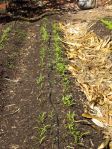 Drip irrigation is a must for all gardeners. I first got the idea while visiting Ardenwood Farm in Newark CA. Their entire fields are watered by drip methods w/ some sprinklers. Not only is it water efficient, but it saves tons of time. Line comes in 12″ and 6″ drip spaces. For plantings like corn or squash, I recommend twelve inch. For spinach, beats, and like plants I advise 6 inch or ‘sponge’ lines. Smaller spaced drips, 6″ or below, will water the length of your entire raised bed.
Drip irrigation is a must for all gardeners. I first got the idea while visiting Ardenwood Farm in Newark CA. Their entire fields are watered by drip methods w/ some sprinklers. Not only is it water efficient, but it saves tons of time. Line comes in 12″ and 6″ drip spaces. For plantings like corn or squash, I recommend twelve inch. For spinach, beats, and like plants I advise 6 inch or ‘sponge’ lines. Smaller spaced drips, 6″ or below, will water the length of your entire raised bed.
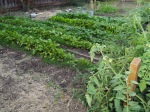 This second planting of spinach and beats, I got wise and skipped a step. Rather than first plant seeds in seedling containers, I broadcasted the seeds along my rows of raised earth. First, I had to replenish the soil with fertilizer from my compost bins. After mixing in fertilizer (decomposed lawn clips and bunny droppings w/ some table scraps), I then raised the earth by digging six inch deep trenches on either side. These trenches were then filled in with chip compost to provide walkways between rows. Meanwhile, I watered down turned earth until clumps broke down into finer particles. Once this was done, I ran my irrigation lines and tapped this all into the local hose. Finally, I scattered the seed along half inch or so deep cuts on either side of the hose, covered them up, and then let regular watering and sun do the rest.
This second planting of spinach and beats, I got wise and skipped a step. Rather than first plant seeds in seedling containers, I broadcasted the seeds along my rows of raised earth. First, I had to replenish the soil with fertilizer from my compost bins. After mixing in fertilizer (decomposed lawn clips and bunny droppings w/ some table scraps), I then raised the earth by digging six inch deep trenches on either side. These trenches were then filled in with chip compost to provide walkways between rows. Meanwhile, I watered down turned earth until clumps broke down into finer particles. Once this was done, I ran my irrigation lines and tapped this all into the local hose. Finally, I scattered the seed along half inch or so deep cuts on either side of the hose, covered them up, and then let regular watering and sun do the rest.
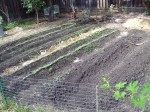 Seedlings arose within three or five days. We were blessed with some early rain in September, and this really caused my spinach, beets, and kale to grow! Nothing is better than rain! Meanwhile, I had some volunteer tomato plants sprout. Sadly, the weather is getting cold, and these volunteers will likely be for naught. Nonetheless, I transplanted them in hopes of one or two November tomatos?!?
Seedlings arose within three or five days. We were blessed with some early rain in September, and this really caused my spinach, beets, and kale to grow! Nothing is better than rain! Meanwhile, I had some volunteer tomato plants sprout. Sadly, the weather is getting cold, and these volunteers will likely be for naught. Nonetheless, I transplanted them in hopes of one or two November tomatos?!?
I am catching up on this blog. Meanwhile, I hope to post a few things regarding my church on St. Francis and Hallowmas! Nice pixs coming.







